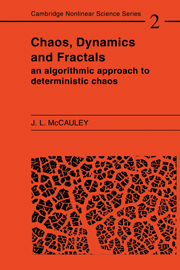Book contents
- Frontmatter
- Dedication
- Contents
- Preface
- Miscellaneous Frontmatter
- Introduction
- 1 Flows in phase space
- 2 Introduction to deterministic chaos
- 3 Conservative dynamical systems
- 4 Fractals and fragmentation in phase space
- 5 The way to chaos by instability of quasiperiodic orbits
- 6 The way to chaos by period doubling
- 7 Introduction to multifractals
- 8 Statistical mechanics on symbol sequences
- 9 Universal chaotic dynamics
- 10 Intermittence in fluid turbulence
- 11 From flows to automata: chaotic systems as completely deterministic machines
- Bibliography
- Index
7 - Introduction to multifractals
Published online by Cambridge University Press: 05 October 2013
- Frontmatter
- Dedication
- Contents
- Preface
- Miscellaneous Frontmatter
- Introduction
- 1 Flows in phase space
- 2 Introduction to deterministic chaos
- 3 Conservative dynamical systems
- 4 Fractals and fragmentation in phase space
- 5 The way to chaos by instability of quasiperiodic orbits
- 6 The way to chaos by period doubling
- 7 Introduction to multifractals
- 8 Statistical mechanics on symbol sequences
- 9 Universal chaotic dynamics
- 10 Intermittence in fluid turbulence
- 11 From flows to automata: chaotic systems as completely deterministic machines
- Bibliography
- Index
Summary
Incomplete but optimal information: the natural coarsegraining of phase space
How can one characterize an invariant set of a chaotic dynamical system and the motion on that set in a way that makes basic theoretical quantities of interest available for comparison with experiment or computation? Because a formulation of the theory based upon finite resolution is needed in both cases, we generalize the results of Chapter 4 and introduce a formalism that is based upon a hierarchy of more and more refined coarsegrained descriptions of both the invariant set and the motion. Within this finite description, it is sometimes useful to introduce the f(α)-spectrum. The f(α)-spectrum, in the end, depends upon two things: the invariant set and the frequency with which the dynamical system visits different parts of the invariant set. A coarsegrained description of both properties is demanded by virtue of the fact that invariant sets of chaotic dynamical systems have, mathematically, the cardinality of the continuum.
We have seen by the example of the Lorenz model that strange attractors can lead at least approximately to one-dimensional chaotic maps (Chapter 2). In that case, one starts with a certain time series {z(t)} that follows from plotting maxima of the z coordinate against the time, yielding a sequence of numbers z(tn) = zn at discrete times tn, where n = 1,2, 3, … In the Lorenz model, the phase space flow is three-dimensional and the points on the orbit that include the discrete time series {zn} do not fall within a single plane, nor is there any known simple analytic pattern among the various times {tn}.
Information
- Type
- Chapter
- Information
- Chaos, Dynamics, and FractalsAn Algorithmic Approach to Deterministic Chaos, pp. 186 - 211Publisher: Cambridge University PressPrint publication year: 1993
Accessibility standard: Unknown
Why this information is here
This section outlines the accessibility features of this content - including support for screen readers, full keyboard navigation and high-contrast display options. This may not be relevant for you.Accessibility Information
- 1
- Cited by
